
Posers
October 23rd, 2008
There's nothing like chickadees to make a nature photographer feel like a million bucks.
They almost seem to be helping you out. "Over here! Me me me! Photograph me. No wait, the light is all wrong. Let me move over there. Okay, here we go. Cheese!"
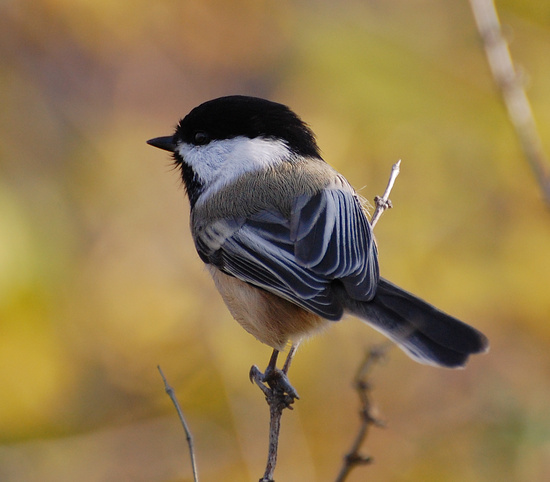
1680x1050 wallpaper
So I went down to Henry's camera shop today. I learned that there is, in fact, a lens that does 400mm zoom and is in my price range (just). Yay!
I also learned that, dear god, I need steroids to carry that thing. Way too heavy for handheld shooting + my arm strength. Unyay. Since I don't like the idea of having to lug a tripod everywhere, 70-300mm it is. So I (re-)bought it and went down to Mud Lake with it this afternoon. Got lots of distant poor-quality shots of interesting birds (Wood Ducks, Common Goldeneyes, Scaup), and several glorious pictures of chickadees.
I have high hopes of what I'll be doing with this lens in the future! Common Goldeneyes winter in Ottawa by the hundreds. They can sometimes be seen quite close to shore on the Rideau River rapids (when the rest of the river is frozen over). In late winter, they start courting, and Common Goldeneye mating rituals are...quite something.
But today, you get chickadees.

1680x1050 wallpaper
Ottawa River Sunset
October 14th, 2008
There's a spot by the Ottawa River, a short distance east of Andrew Haydon Park, that produces the most beautiful sunsets. I had resolved that I would return there with camera in hand on a promising, mostly cloudy evening, and fill a memory card. Yesterday evening was such an evening.
As it turned out, the day I picked was smack dab in the middle of fall waterfowl migration. The long line of specks in the water (more visible at wallpaper res) is an evening roost of Canada Geese. By the time I was done shooting, there were literally thousands of them.
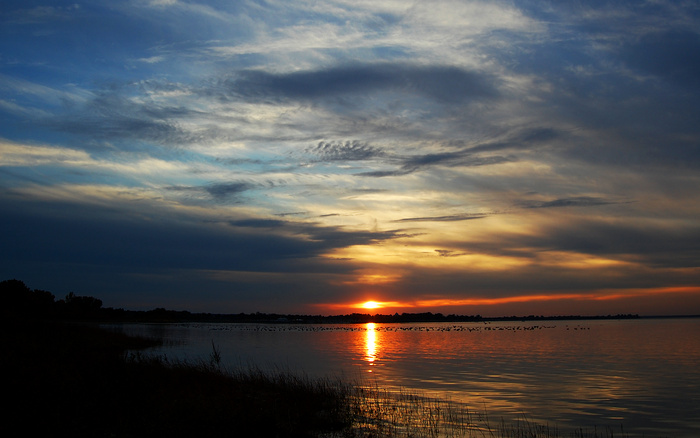
1680x1050 wallpaper
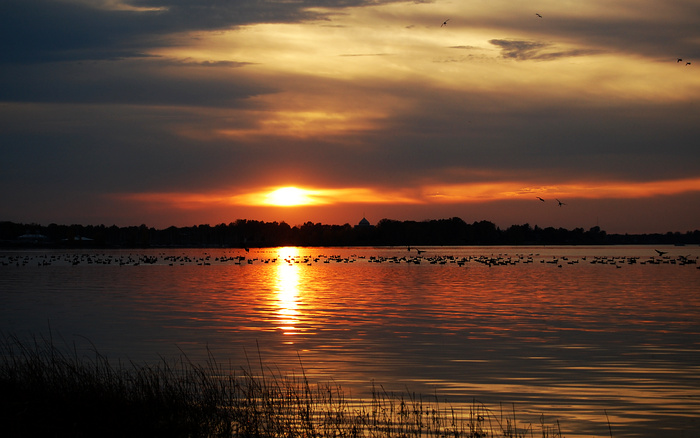
1680x1050 wallpaper
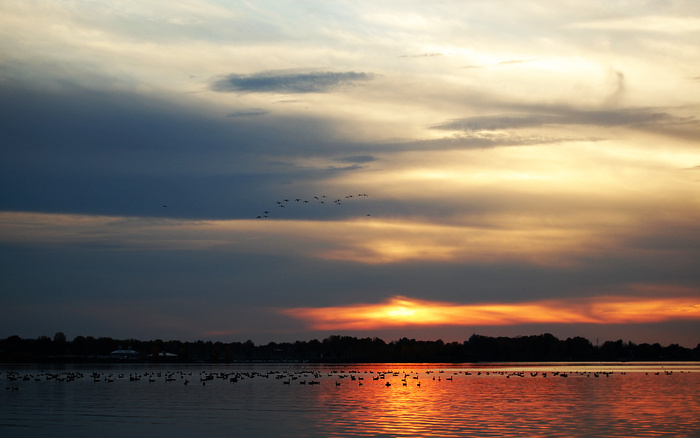
1680x1050 wallpaper
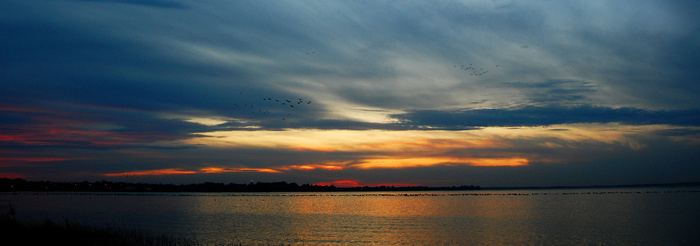
1680x1050 wallpaper
The Joys Of Photographing Kinglets
October 5th, 2008
The birding has been spectacular lately. I've been out at Mud Lake this weekend enjoying the influx of kinglets, sparrows and thrushes. But I'm not posting to tell you about birding, per se. The topic is photography. Yesterday was the day when I finally went out and purchased my spiffy new $600+ zoom lens. And today was the day when I returned my spiffy $600+ zoom lens.
I took it out to Mud Lake yesterday afternoon and shot everything I could over a space of four hours. And in the process I learned a few things.
- 300mm is not enough zoom.
- When shooting small birds in thick foliage, autofocus is worse than
useless.
- VR (vibration reduction) works surprisingly well.
- The sun will be where you do not want it to be. Always.
- I now understand why I get borderline-hostile stares from some nature
photographers. It's because nature photographers secretly wish everyone else
in the world would CEASE TO EXIST (and thus cease to scare away the damn
wildlife) until they're finished taking the shot.
- Photographing Golden-Crowned Kinglets is an exercise in self-torture.
The good news about photographing kinglets is that they're very bold--you can get within six feet of them and they evince no greater alarm than your average chickadee. The bad news about photographing kinglets is that they are the most hyperactive birds in the universe. Now refer back to what I said about autofocus being useless, and picture me carefully adjusting the focus wheel to zero in on a bird that moves every .000002 femtoseconds, and you'll have a good idea of how I spent my afternoon.
I worked, and worked, and worked. And finally was rewarded with this:
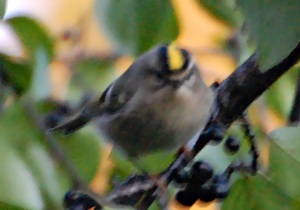
...and I'm convinced that the photographers who have taken sharp, in-focus pictures of Golden-Crowned Kinglets have captured and drugged them.
Anyway, the short story is that I need more skill, and I need more patience, but I also need more zoom to take the kinds of pictures I want. So I took the lens back, and I'm going to research the possibility of more focal length, and frankly, I'm going to seriously consider whether I want to take up the hobby of bird photography. Maybe I should try something less challenging. Like ice climbing.
Hike At Night
August 26th, 2008
Or hike at sunset, anyway, and bring along a good pair of low-light-tolerant binoculars.
I went out to Old Quarry Trail today around 5:30PM. I hiked around for an hour, didn't see much (other than the usual deer and a few common breeding birds), and went back to Hazeldean Mall to have dinner. After dinner I was going to head home, but thought "well, marsh birds are often more active at dusk, lets give it one more try"--and went back out. Which is when all the cool stuff happened.
At 8:00PM, after creeping back and forth on the boardwalk for about fifteen minutes, I saw a medium-sized bird silhouetted behind the cattails. I very slowly and quietly sat down cross-legged, lifted my binoculars, and watched as it came out into the open: my first Virginia Rail, a shy and secretive marsh wader. This made my day. And my week. And my month.
At 8:15PM I saw a Snowshoe Hare on the path ahead. Rabbits are ubiquitous in a number of places in Ottawa, but this is the first time I'd ever seen a hare. I didn't realize how different they looked: this one was standing half-upright, and his posture reminded me of a kangaroo. At 8:20, a pair of porcupines--mother and child, I think--ambled by in the woods. Shortly thereafter a third porcupine began to come down out of his tree for the night. Said tree was about five feet away from me.
For obvious reasons, I didn't stick around.
A Meal For A Merlin
August 20th, 2008
I saw something new at Mud Lake yesterday evening. Not a new species, but a particular bird-watching "slice of life" that I had never witnessed before: a raptor in flight with catch in hand. He was off in the distance flying towards the river. Knowing that wherever he landed, he'd likely stay there awhile, I followed, and found him in a tree with a chickadee dangling from his talons. He was a Merlin: a handsome blue-jay-sized falcon of the north.
If you ever want to find a raptor, follow the noise. Some birds have alarm calls for raptors on the hunt, but that's nothing compared to the amount of noise all songbirds make when a raptor with prey in hand perches nearby and starts eating. It's a sound I can only call "outrage." In this case, the Merlin apparently got fed up with it, because he flew away to dine at a more secluded location. One particularly gutsy chickadee chased after him as he left.
Dow's Lake
August 1st, 2008

1680x1050 wallpaper
The Rideau Canal at Dow's Lake, shortly before sunset.
An Afternoon At Mud Lake
July 29th, 2008
Since this was one of the few nice days we've had in awhile, I left work an hour early (I'll make it up on a rainy day) and went birding at Mud Lake in Britannia, and was treated to the sight of a Cooper's Hawk by the Ottawa River, perched calmly in a tree full of angry chickadees and angrier starlings, and having dinner. Raptors are one of my favorite kinds of birds, and even though I love songbirds too, when I see a hawk at the chase or having a meal, for whatever reason my sympathies always lie with him. I silently cheer when he makes the catch, and silently empathize when it gets away. Maybe it's because I have some idea of how challenging his lifestyle is. (According to a study, a good percentage of Cooper's Hawks have healed chest bone fractures.)
Other highlights include: all three of Ottawa's common breeding herons (Great Blue, Green, Black-Crowned Night), Chimney Swifts, a Mallard with three surprisingly young (for late July) ducklings, and a small flock of Bonaparte's Gulls on the river. I gather that last is an early migration event, since Bonaparte's Gulls generally breed well north of here.
By the end of this year I'll have a telephoto lens so I can give you pictures instead of just hyperlinks!
Symmetry
July 23rd, 2008

Outer Banks Photos
July 18th, 2008
A series of sunrise photos, taken just outside our cottage at Cape Hatteras this summer.

1680x1050 wallpaper

1680x1050 wallpaper
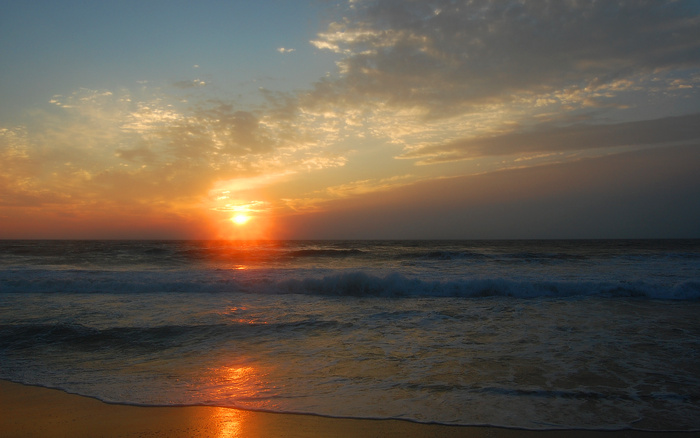
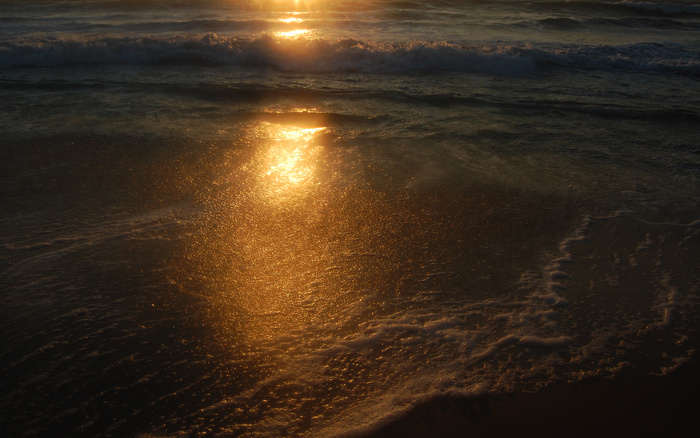
1680x1050 wallpaper

Home Sweet
July 16th, 2008
My parents have vacationed in the Outer Banks since I was five years old, and I usually go with them--typically a week in Virginia and a second week in Nags Head or Cape Hatteras. Ever since I became a birder (May of last year), I've delighted in the birds of the south. Any season of the year, there's so much to see.
I just got back from this summer's trip. My total species list numbers 70, with 13 lifers! One of the place I visited several times was Pea Island Wildlife Refuge, but it wasn't responsible for all or even most of the lifers. One of them (Blue-Gray Gnatcatcher) was even in my parents' backyard! This is the joy of travelling for a birder: species that are common to the locals are exotic to you.
( Species List )
I'll post some scenery photos from the trip in a few days.
|
